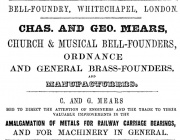Charles and George Mears
of Bell-Foundry, Whitechapel, London
1844 Charles and George Mears took over from their father Thomas Mears as master founders at the Whitechapel Foundry
1844 Cast the 15 bells for the clock at the Royal Exchange; at Mr Dent's suggestion the number of bells had been increased to cover 3 octaves[1]
1846 There was ongoing discussion about the chimes in the Royal Exchange clock. Mr Dent was responsible for the mechanism[2]
1849 Charles and George Mears worked on correcting the chime mechanism of the Royal Exchange Bells[3]
1853 Charles Mears died
1858 After the cracking of the first Great Bell for the Parliament in London (Big Ben), it was recast by George Mears at the Whitechapel Bell Foundry using the reclaimed bell metal. The second bell was cast on 10 April 1858.
This bell was 2.5 tonnes lighter than the first. Its dimensions meant it was too large to fit up the Elizabeth Tower's shaft vertically so it was turned on its side and winched up. It took 30 hours to winch the bell to the belfry in October 1858. The four quarter bells, which chime on the quarter hour, were already in place.
1859 Big Ben rang out on 11 July but the success was short-lived. In September, the new bell also cracked and Big Ben was silent for four years until the problems were solved by turning the bell by a quarter turn, so the hammer struck a different spot, using a lighter hammer and preventing the crack from spreading by cutting a small square into the bell [4]
1859 Wrote to "The Times" to counter the suggestions made by Mr Denison about the casting of the bell for Westminster (Big Ben)[5]
1860 The highlights of the law-suit between Mears and Denison about the disaster can be seen at The Engineer 1860/01/06, page 11.
1861 Succeeded as master founders by George Mears and Co
1865 Succeeded by Mears and Stainbank[6]


